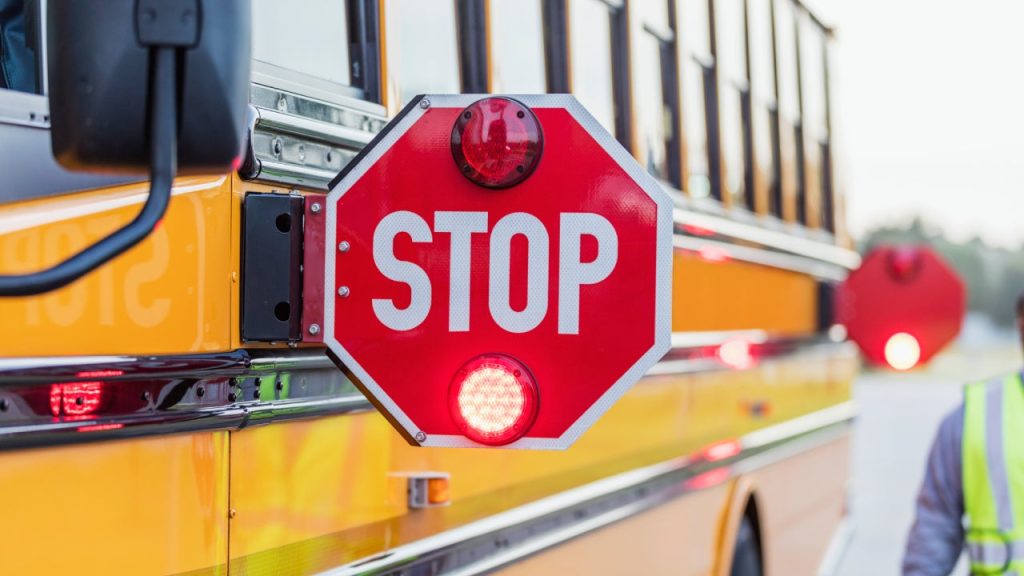The school year is underway across the U.S., and with that, safety in school zones becomes a priority for parents and communities. Take Texas, for example: in 2023 alone, 748 traffic crashes occurred in school zones, tragically resulting in one death and 14 serious injuries. While Texas is just one example, states nationwide may experience similar — or even more severe — statistics as children head back to school. With so much at stake, understanding the rules of the road in school zones isn’t just about avoiding fines; it’s about preventing tragedies.
The specific penalties and laws surrounding school zones will vary depending on where you live, but the importance of caution remains the same everywhere. Whether it’s obeying reduced speed limits, stopping for school buses or watching for children crossing the street, drivers play a critical role in school zone safety. Understanding your community’s rules and the consequences of breaking them is of the utmost importance for protecting young lives and staying mindful on the road.
Speeding in a school zone
School zones are meant to protect children, but speed limits within these zones vary widely depending on where you are. Throughout the United States, school zone speed limits tend to range from 15 to 35 miles per hour during active school hours, but the consequences for exceeding these limits can be severe. For example, driving 10 mph over the speed limit in a school zone in Harris County, Texas, can result in a $160 fine. Meanwhile, in Florida, a similar offense will likely cost you $200, and in New York, speeding even just 1-10 mph over the limit could set you back anywhere from $178 to $693.
Violating school zone speed limits not only carries the risk of costly fines — it could also significantly impact your car insurance premiums. Car insurance companies often view speeding tickets, especially those in school zones, as indicators of risky behavior. Your rates could go up after a violation, which may affect your wallet long after the fine is paid.
With that in mind, let’s examine which states impose the highest and lowest penalties for various school zone infractions, both in terms of fines and potential increases in car insurance costs.
Most expensive states for school zone speeding tickets
Speeding in a school zone is considered a serious violation, and beyond fines, it can significantly impact your car insurance premiums. In some states, the increase in insurance costs after receiving a school zone speeding ticket is particularly steep, leading to higher monthly payments for both minimum and full coverage. The table below outlines the financial effect of these violations on your insurance premiums, providing insight into how much a school zone speeding ticket could cost you in the long run.
| State | Average minimum coverage after ticket | Average full coverage after ticket | % increase for minimum coverage after ticket | % increase for full coverage after ticket |
|---|---|---|---|---|
| New York | $1,740 | $4,064 | 12% | 8% |
| Florida | $1,305 | $4,030 | 24% | 17% |
| New Jersey | $1,272 | $3,101 | 26% | 26% |
| Nevada | $1,238 | $3,794 | 25% | 22% |
| Connecticut | $1,230 | $3,126 | 30% | 27% |
| *data provided by Quadrant Information Services, as of September 2024 |
Least expensive states for school zone speeding tickets
While some states may impose lower fines for school zone speeding violations, that doesn’t mean the insurance impact is negligible. Even in states with less severe penalties, your car insurance premiums could rise significantly after a school zone speeding ticket. The table below highlights how these violations can affect insurance rates for both minimum and full coverage in states with typically more affordable car insurance rates.
| State | Average minimum coverage after ticket | Average full coverage after ticket | % increase for minimum coverage after ticket | % increase for full coverage after ticket |
|---|---|---|---|---|
| Wyoming | $328 | $2,329 | 27% | 36% |
| Vermont | $339 | $1,492 | 13% | 7% |
| South Dakota | $411 | $2,557 | 20% | 14% |
| Idaho | $416 | $1,601 | 22% | 21% |
| Iowa | $432 | $2,194 | 27% | 20% |
| *data provided by Quadrant Information Services, as of September 2024 |
How does a school zone speeding ticket impact my driving record?
A speeding ticket in a school zone is more than just a momentary lapse in judgment — it’s a serious offense that can follow you for years. Depending on where you live, the violation may stick to your driving record for quite some time, adding points that could eventually push your insurance premiums higher. In some cases, accumulating too many points can even result in a license suspension, putting your driving privileges at risk.
Beyond the fine, some states might also require you to attend traffic school or pay additional surcharges. The ripple effects of a school zone speeding ticket can be felt long after you’ve paid the ticket, making it important to stay within posted speed limits and drive with extra caution where children are present. The consequences may linger, but safe driving habits can help you avoid this costly mistake altogether.
School bus safety violations
When it comes to school buses, the rules of the road are designed to protect children as they board and exit safely. Failing to yield or improperly passing a school bus are not just minor infractions; they’re serious offenses that can result in heavy fines, points on your driving record and potentially increased insurance rates. Across the U.S., most states have strict laws requiring drivers to stop when a school bus is loading or unloading children, with few exceptions. Violating these laws can carry steep penalties, as children’s safety is paramount.
For example, in Texas, drivers must stop for school buses when their red lights are flashing, no matter where they’re coming from, unless the road is divided by a physical barrier. Those who violate this law could face fines as high as $1,250, and in more serious cases or with repeat offenses, drivers might even have their license suspended or face jail time.
Similarly, Florida takes school bus violations very seriously. Penalties for passing a stopped school bus that results in serious injury or death are severe, including 120 community service hours in a trauma center or hospital, attending a victim’s impact panel, accumulating six points on the driver’s license, a minimum one-year license suspension and a hefty $1,500 fine.
These examples highlight the gravity of school bus safety violations and the importance of always yielding to a school bus when it signals to stop.
Most expensive states for school bus violations
After receiving a ticket for failing to yield to or improperly passing a school bus, drivers in some states may see sharp increases in both their minimum and full coverage rates. The tables below highlight how insurance premiums can be affected in the most expensive states for these school bus violations.
Failure to yield to a school bus
| State | Average minimum coverage after ticket | Average full coverage after ticket | % increase for minimum coverage after ticket | % increase for full coverage after ticket |
|---|---|---|---|---|
| New York | $1,729 | $4,045 | 11% | 8% |
| New Jersey | $1,299 | $3,148 | 29% | 28% |
| Connecticut | $1,283 | $3,285 | 36% | 33% |
| Louisiana | $1,276 | $4,799 | 34% | 30% |
| Nevada | $1,246 | $3,827 | 26% | 23% |
| *data provided by Quadrant Information Services, as of September 2024 |
Improperly passing a school bus
| State | Average minimum coverage after ticket | Average full coverage after ticket | % increase for minimum coverage after ticket | % increase for full coverage after ticket |
|---|---|---|---|---|
| New York | $1,733 | $4,058 | 12% | 8% |
| New Jersey | $1,481 | $3,535 | 47% | 44% |
| Nevada | $1,290 | $3,948 | 31% | 27% |
| Louisiana | $1,290 | $4,857 | 35% | 32% |
| Connecticut | $1,243 | $3,054 | 32% | 24% |
| *data provided by Quadrant Information Services, as of Sept. 2024 |
Least expensive states for school bus violations
While the financial impact of a school bus violation may be less severe in some states, it still poses the risk of increased insurance costs. Even in states with lower penalties for these infractions, drivers could see a rise in both minimum and full coverage premiums. The table below shows how insurance rates can change after a school bus violation in the least expensive states.
Failure to yield to a school bus
| State | Average minimum coverage after ticket | Average full coverage after ticket | % increase for minimum coverage | % increase for full coverage |
|---|---|---|---|---|
| Wyoming | $292 | $1,859 | 12% | 9% |
| Vermont | $339 | $1,492 | 13% | 7% |
| Iowa | $409 | $2,127 | 20% | 16% |
| South Dakota | $416 | $2,575 | 21% | 15% |
| Idaho | $417 | $1,596 | 23% | 20% |
| *data provided by Quadrant Information Services, as of September 2024 |
Improperly passing a school bus
| State | Average minimum coverage after ticket | Average full coverage after ticket | % increase for minimum coverage | % increase for full coverage |
|---|---|---|---|---|
| Wyoming | $292 | $1,859 | 12% | 9% |
| Vermont | $362 | $1,612 | 20% | 15% |
| South Dakota | $426 | $2,645 | 24% | 18% |
| Idaho | $455 | $1,728 | 34% | 30% |
| Iowa | $460 | $2,350 | 35% | 29% |
| *data provided by Quadrant Information Services, as of September 2024 |
Failure to obey a school crossing guard
With school back in session, the streets are bustling with children eager to learn with crossing guards in bright vests guiding them across the road safely. These crossing guards act as protectors, stepping into busy traffic to ensure that every child gets to school without harm. It’s not just common sense to follow their instructions — it’s the law. When a crossing guard raises their hand or signals you to stop, it’s mandatory to do so until everyone, including the guard, has safely crossed.
In states like Nevada, the law takes these violations seriously. Drivers who fail to stop for a school crossing guard can face hefty consequences. Under Nevada’s law, ignoring a crossing guard’s signal could cost you up to $1,000 in fines, six months in jail and the potential for community service if someone is injured.
But the consequences don’t stop at fines or a court appearance. Failing to obey a school crossing guard can cause a ripple effect, hitting your car insurance hard. As we break down the financial impact of these violations, it becomes clear that one bad decision can cost you more than just a moment of impatience.
Most expensive states for failing to obey a school crossing guard
Disobeying a school crossing guard can do serious damage to your bank account, especially when it comes to your car insurance premiums. In some states, the cost for this violation is particularly high, with insurance rates spiking after the offense. The table below highlights the most expensive states where disobeying a crossing guard’s signal can lead to steep increases in your car insurance premiums.
| State | Average minimum coverage after ticket | Average full coverage after ticket | % increase for minimum coverage | % increase for full coverage |
|---|---|---|---|---|
| New York | $1,729 | $4,045 | 11% | 8% |
| New Jersey | $1,276 | $3,092 | 27% | 26% |
| Nevada | $1,246 | $3,822 | 26% | 23% |
| Connecticut | $1,239 | $3,144 | 31% | 27% |
| Louisiana | $1,226 | $4,627 | 29% | 26% |
| *Data provided by Quadrant Information Services, as of Sept. 2024 |
Least expensive states for failing to obey a school crossing guard
Some states might offer relief regarding the fines and insurance costs of disobeying a crossing guard. However, it’s still a violation that can increase insurance premiums. Even in states with lower penalties, the financial impact can add up over time. The following table illustrates how much your insurance could increase in the least expensive states for crossing guard violations.
| State | Average minimum coverage after ticket | Average full coverage after ticket | % increase for minimum coverage | % increase for full coverage |
|---|---|---|---|---|
| Wyoming | $292 | $1,859 | 12% | 9% |
| Vermont | $339 | $1,492 | 13% | 7% |
| Iowa | $398 | $2,086 | 17% | 14% |
| South Dakota | $404 | $2,511 | 18% | 12% |
| Idaho | $408 | $1,566 | 20% | 18% |
| *Data provided by Quadrant Information Services, as of Sept. 2024 |
How will failing to obey a school crossing guard affect my driving record?
Failing to obey a school crossing guard can leave a lasting imprint on your driving record, with consequences that extend well beyond the initial ticket. Here’s how a violation can affect you:
- Points on your license: Many states add points to your driving record for disobeying a crossing guard. Accumulate too many, and you could face penalties like increased fines or even license suspension.
- Higher insurance premiums: Car insurance companies view these violations as risky behavior. This could lead to higher premiums, costing you more each month to maintain your coverage.
- Traffic school requirements: In some cases, drivers may be required to attend traffic school to reduce points on their license or as part of court-ordered conditions.
- Additional surcharges: Beyond fines, some states impose surcharges lasting several years. For instance, in states like New Jersey, you may be required to pay an annual surcharge that can range from $100 up to $1,500 for certain violations, with the surcharges sticking around for three years. These surcharges are typically added to the total cost of your penalties and can quickly add up, making even a seemingly minor violation expensive in the long run.
How can drivers ensure safety in school zones?
School zones are designed to be safe havens for children, but every driver must do their part to keep these areas accident-free. While the flashing lights and reduced speed limits are there as a reminder, staying alert is ultimately up to each driver. So, how can you navigate school zones safely?
- Slow down: Speed limits in school zones are significantly lower for a reason. Always reduce your speed, even if you’re in a rush. One second saved isn’t worth the risk.
- Eliminate distractions: Put down the phone, turn off the radio and focus on the road. Distracted driving is one of the leading causes of accidents in school zones.
- Look for children: Kids can be unpredictable; they might dart between parked cars or cross in areas without a crosswalk. Be vigilant and ready to stop at any moment.
- Obey crossing guards: These local heroes are there to protect children. Always follow their directions and don’t proceed until the road is clear.
Remember, driving safely in a school zone isn’t just about avoiding tickets; it’s about keeping the next generation safe as they make their way to and from school.
Special considerations for school bus stops
School bus stops are bustling with activity and the responsibility of keeping these areas safe falls on both drivers and pedestrians. For drivers, the golden rule is simple: always stop when the bus stops. If you see the red lights flashing and the stop arm extended, it’s your cue to come to a complete halt — regardless of which direction you’re coming from (unless there’s a median dividing the road). Failing to stop isn’t just illegal; it puts children’s lives at risk.
For those waiting at the bus stop:
- Stand back: Keep a safe distance from the curb and never run toward the bus. Wait until the bus has fully stopped and the driver signals it’s safe to approach.
- Be visible: If you’re waiting early in the morning or late in the afternoon, make sure you and your child are visible to drivers. Bright clothing or reflective gear can make a big difference.
- Stay alert: Avoid distractions, like phones or loud conversations, that could prevent you from noticing oncoming traffic or bus signals.
Frequently asked questions
Methodology
Bankrate utilizes Quadrant Information Services to analyze September 2024 rates for all ZIP codes and carriers in all 50 states and Washington, D.C. Rates are weighted based on the population density in each geographic region. Quoted rates are based on a single, 40-year-old male and female driver with a clean driving record, good credit and the following full coverage limits:
- $100,000 bodily injury liability per person
- $300,000 bodily injury liability per accident
- $50,000 property damage liability per accident
- $100,000 uninsured motorist bodily injury per person
- $300,000 uninsured motorist bodily injury per accident
- $500 collision deductible
- $500 comprehensive deductible
To determine minimum coverage limits, Bankrate used minimum coverage that meets each state’s requirements. Our base profile drivers own a 2022 Toyota Camry, commute five days a week and drive 12,000 miles annually.
These are sample rates and should only be used for comparative purposes.
Incidents: Rates were calculated by evaluating our base profile with the following incidents applied: clean record (base), speeding in a school zone, failure to yield to a school bus, improperly passing a school bus and failure to obey a school crossing guard.
Read the full article here












